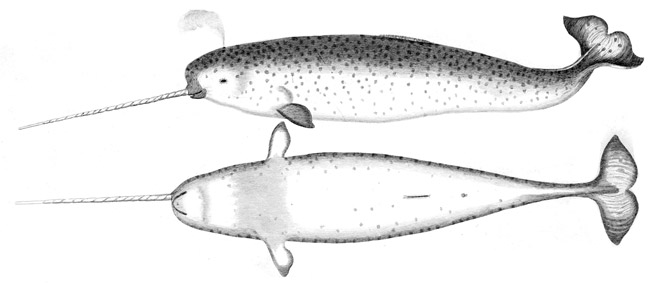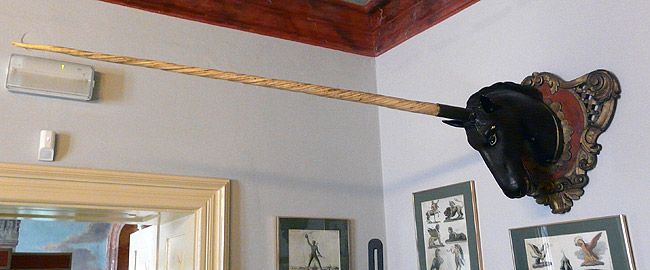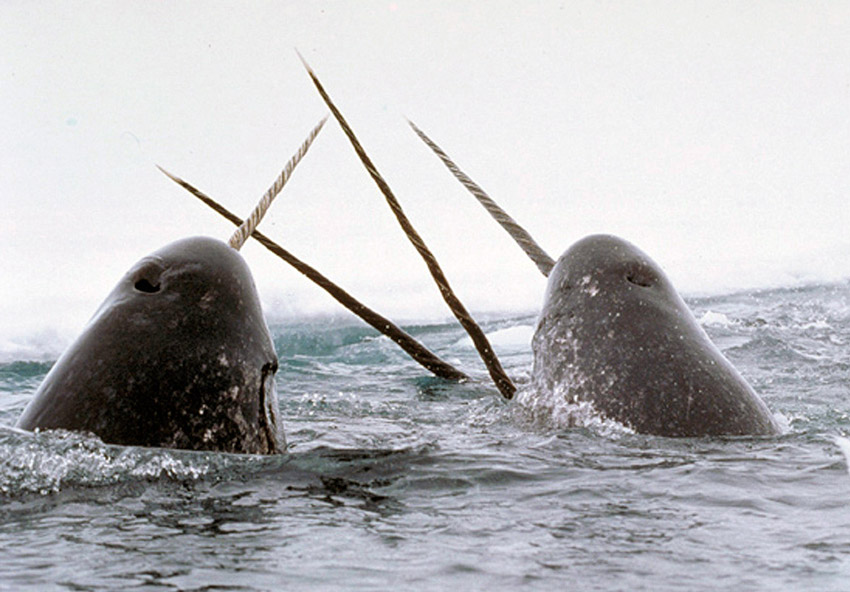Narwhals - Facts and Adaptations
Monodon monoceros
Medium sized toothed whales with just the single long tusk is present in males and about 15% of females. Animals of the far north and the original unicorns.
narwhal facts Basics
Average Weight: 800 - 1,600 kg (1,800
- 3,500 pounds)
Average Length:
395 to 550 cm long (13 - 18 feet) not including the tusk
which is 150 - 310 cm (4.9 - 10.2 feet). Males are
slightly larger than females usually it is males that have
a tusk.2.6m
Breeding Season: Narwhals
breed at the end of the winter out in deep water, gestation
lasts for about 14-16 months and the following summer calves
are born in shallow water where the whales migrate to in
the summer months. They have one calf every 3 years or so
and become reproductive after 5 years for females and 8
years for males.
Estimated world population:
75,000
Feeding & diet: A limited
range of fish, Greenland halibut, Arctic cod, polar cod,
squid and shrimp with occasional others. Other than the
tusk narwhals are toothless, no-one has seen them feeding
in the wild as it happens in the depths of icy seas but
it is thought they ingest their prey with a powerful suck.
It is by looking at the stomach contents of dead narwhals
that their diet has been determined and also their dive
depth as some fish species they feed on are only found below
certain depths.
Conservation status:
Near threatened.
Distribution:
High Arctic Ocean, unlike many other whales they don't
migrate away from this region remaining through the winter
months. Most are found in the fjords of North Eastern Canada
and Western Greenland.
Predators:
Killer whales (orcas) and polar bears. The bears may kill
them at leads or polynyas in the winter sea ice by reaching
them with their sharp claws when they have to surface to
breathe at a possibly shrinking open water area. They are
also hunted by Inuit around the Arctic as they have been
for hundreds, possible thousands of years.
 Distribution
range of narwhals
Distribution
range of narwhals
What are Narwhals like? how do they survive?

 Narwhals
are warm blooded air breathing mammals that give birth
to live young that suckle on milk. They belong to a group called
the Cetaceans that includes the large baleen whales
such as blue and humpbacks and also smaller toothed whales like
orcas, dolphins and porpoises. Narwhals are medium sized toothed
whales although they don't have any teeth other than the
tusk, there are vestigial teeth when they are young, but these
never erupt and disappear before maturity.
Narwhals
are warm blooded air breathing mammals that give birth
to live young that suckle on milk. They belong to a group called
the Cetaceans that includes the large baleen whales
such as blue and humpbacks and also smaller toothed whales like
orcas, dolphins and porpoises. Narwhals are medium sized toothed
whales although they don't have any teeth other than the
tusk, there are vestigial teeth when they are young, but these
never erupt and disappear before maturity.
Narwhals are very difficult to study as they are large fast swimming animals that live in very cold seas in very remote parts of the world. It is difficult and costly to get to where they live and difficult and costly to find out much about them when you are there, consequently their biology is not very well known. Inuit people's hunt narwhals for food which provide some specimens that may be studied to provide information about them. They can also be tracked by satellite transmitters attached to their backs.
Narwhals live in groups of 10-100 individuals though can sometimes form much larger groups.
Narwhal Tusks
The most obvious and striking feature of narwhals is the tusk. This is an elongated canine tooth and is mainly found in males though around 15% of females also have a tusk albeit shorter and with a less pronounced spiral. The tusk is the left upper canine tooth and has a fairly tight left handed spiral which is thought to keep the tusk straight as it grows rather than curving as in other animals with tusks such as elephants and pigs which would cause problems when swimming. Very occasionally a male will grow two tusks, one from each side though the right tusk also has a left hand spiral rather than being a mirror image as might be expected, around 1 in 500 male narwhals have two tusks. The tusks don't grow out below the lip, they actually grow entirely horizontally in relation to the skull so actually break through the upper lip rather than emerging from the mouth as do other animals tusks.
While the tusk is essentially a tooth it has a structure rather different to that of a typical tooth being sort of inside-out with the outside being porous and the hard, usually external enamel layer in the center the opposite way to your teeth. There is a pulp at the very center (like other mammalian teeth) which has blood vessels and nerves and in the order of ten million channels that allow sea-water to enter the tusk.
The purpose of the tusk was for a long time unknown or at least unproven. That only males always have fully developed tusks indicates that there is some element of sexual selection in its function in that the tusk somehow enables males to compete for access to females. There is no evidence to show that male narwhals use the tusks to fence in duels with each other as once thought, though males have been seen touching their tusks with other males in non-combative interactions. It is possible that the tusks are largely for show only when it comes to mate selection like a peacock's tail. It has been suggested that they may be used to break ice or spear prey (how will it get it off?) though there is no evidence for either of these things.
What has relatively recently been found is that the tusks are highly sensitive sense organs thanks to all those tiny little channels. They will be able to detect water pressure (and so depth), temperature and salinity. However discovering the role of the tusk as a sense organ raises as many questions as it answers, if it is so sensitive and so useful, then why don't females always have one? Anything that could aid finding food would be of more value to females than males as they need the extra nutrition during pregnancy and during suckling.
Historically
From Viking times and through to the Middle Ages in Europe narwhal tusks were thought to be the horns of unicorns. Merchants kept their true origin secret and they were sold for huge prices, up to ten times the equivalent weight in gold thanks to their reputed magical powers. They were thought to neutralize any poison and so were used to make drinking goblets, they could also cure melancholia (they couldn't really), powdered unicorn horn was a vital part of a physicians medicine chest.
Queen Elizabeth of England was given a unicorns (narwhals) horn in the 1500's worth £10,000 at the time, the price of a small castle. They were sometimes used in the thrones and crown jewels of European Royalty.

Austrian Imperial Crown Jewels - Narwhal tusk staff to sceptre

Narwhal tusk mounted as a unicorn horn - Cieszyn muzeum Poland
Narwhal Adaptations:
- Low surface area to volume ratio (anatomical)
- Being large means it is easier to stay warm by retaining
heat generated by the metabolism, narwhals have a clean
shape with only the flippers adding much extra surface area.
- Thick blubber layer under the skin for insulation
(anatomical and physiological) - Blubber or fat
is an excellent source of insulation, it also provides a
means of storing food when times are good and there is plenty
to eat as well as providing buoyancy. Narwhals live in water
that is at a fairly steady temperature around freezing point
all year round. Any other mammal other than whales or seals
would eventually get too cold and die of hypothermia in
these conditions. Whales such as narwhals live their whole
lives in frigid water being always able to maintain a constant
warm mammalian body temperature. Blubber can make up 40%
of a narwhals mass.
- Countercurrent heat exchanger in the flippers
(anatomical and physiological) - A close arrangement
of the arteries entering the flippers and the veins leaving
the flippers means that warm blood entering is cooled down
by the cold blood leaving. In this manner warmth is contained
within the body cavity rather than being lost to the high
surface area - low volume of the flipper. In warmer waters
and after exertion that generates excess heat that must
be lost, the countercurrent exchanger can be made to work
less efficiently so allowing the flippers to dump heat into
the sea.
- Diving physiology (physiological and
anatomical) - Whales and seals have a number of adaptations
that allow them to dive deep beneath the sea for extended
time periods, narwhals can dive to 1,500m (4,900 feet) and
stay submerged for up to 25 minutes.
- The lungs are collapsed lungs on diving
with only the minimum of air held in the respiratory
system. This prevents any retained air (or more specifically
the nitrogen in that air) from being forced into the
blood under pressure at depth and coming out again on
resurfacing so resulting in the "bends" which
can be damaging or even fatal.
- Bradycardia, the slowing down of the heart
considerably from the normal rate. Blood is
directed only towards the vital organs such as the brain
and heart and to the swimming muscles and those associated
with catching prey. The rest of the body is largely
bypassed for the duration of the dive to retain oxygen
for immediately necessary purposes only.
- Large amounts of myoglobin in the swimming
muscles to store oxygen for use during a dive.
Myoglobin is a large protein molecule similar to haemoglobin
that carries oxygen in the blood. Haemoglobin gives
up its oxygen before myoglobin does, so once the haemoglobin
source of oxygen is exhausted, then myoglobin gives
up its oxygen to the muscles enabling them to work efficiently
for longer. large amounts of myoglobin in diving animals
makes their muscle a deep red colour.
- Oxygen loading and ridding of carbon dioxide
before a deep and long dive. Long deep breaths
are taken while at rest before diving to clear dissolved
CO2 from the blood and load up haemoglobin and myoglobin
with oxygen before the dive to enable a longer period
before the next breath.
- The lungs are collapsed lungs on diving
with only the minimum of air held in the respiratory
system. This prevents any retained air (or more specifically
the nitrogen in that air) from being forced into the
blood under pressure at depth and coming out again on
resurfacing so resulting in the "bends" which
can be damaging or even fatal.
- Smooth streamlined shape to enable easy movement
through the water (anatomical) - The tail flippers
are held separately from the body (as in many aquatic animals)
which means that the tail can act as a unique entity for
generating thrust away from the body which has its own hydrodynamic
shape. The tail is connected to the body by a narrow region
only to allow this.
- Nostrils on top of the head forming a blow hole
(anatomical) - In common with other Cetaceans narwhals have
a blow-hole on top of the head making breathing easier when
swimming and surfacing
- Migration towards shallower water around coasts in the summer when the females give birth and then further offshore in the winter (behavioural) - In the winter narwhals move offshore into deeper water where they live amongst open water leads, long strips of ice free areas through the thick pack ice or in polynyas, pools of open water kept that way by wind and tide or even the continued movement of the whales living within them.
Picture use:
Creative Commons Attribution 3.0 license - Unicorn - Piotrus / Austrian
Imperial Crown Jewels - Florian Prischl / 2 tusk skull - soebe / Distribution
map - Pcb21
Creative Commons Attribution 4.0 International license - Vertical
tusk - Wellcome trust


